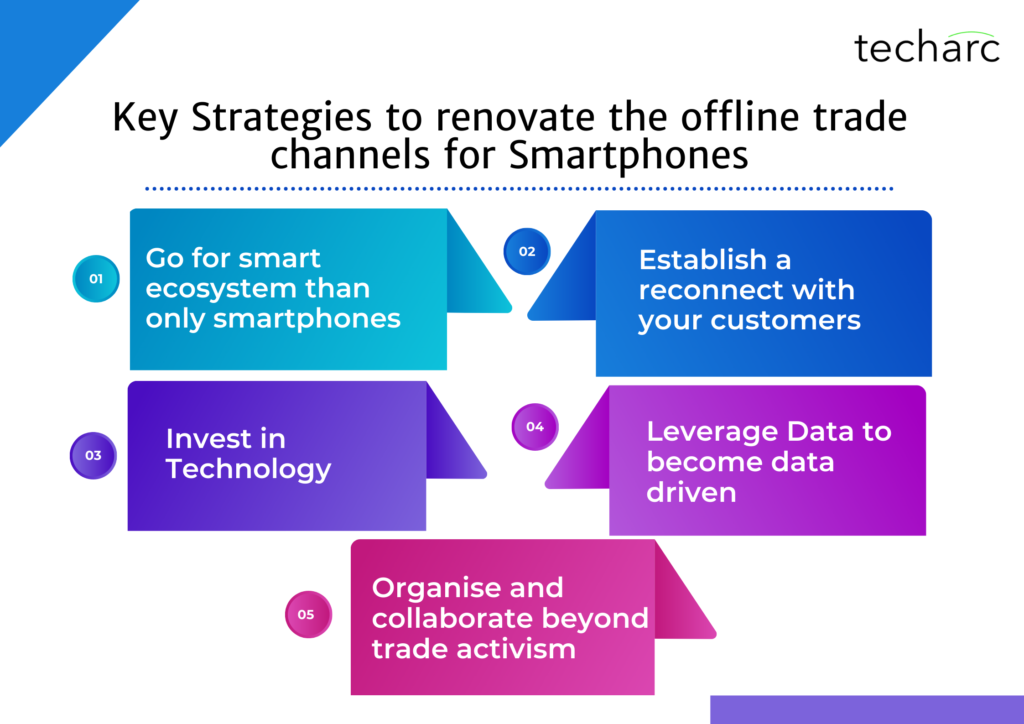For the festive quarter of Oct-Dec, 58% of the smartphones expected to be sold over online channels by volume, contributing more than 52% of the total value sales.
Techarc recently launched Smart Seller Initiative, which is an exclusive information and insights programme for the trade channels to bridge the information deficiency gap in among retailers and other trade partners of the brands. In a dipstick survey done by Techarc in 2019, within NCR, it was found that 7 out of 10 retailers in the offline do not see brands educating them beyond giving the fundamental tips to sell the smartphones. The only brands which matched their expectation in terms of empowering them with information around products were Samsung and Apple.
In its inaugural session, veteran mobile handset business leader and advisor Techarc, Ajay Sharma and Faisal Kawoosa, Founder & Chief Analyst Techarc, discussed about the key challenges in the short and long term for the offline trade channel and ways to overcome them. They also took select questions received through the channel fraternity capturing the main themes which included: –
- Is offline still relevant for smartphones? How do channel partners retain and regain the business?
- What can they do when the brands are promoting online along with the enabling ecosystem including financial and other services?
- With the present supply chain issues, there is availability issue with the offline channel. Is there anything that they can do?
- Should the channel partners stay with incumbent brands who offer better margins and, also participate in working capital through credit facility, etc., or go with the fast-moving brands which have wafer thin margins and work on cash and carry model?
- How can the offline trade channel create sustainable differentiators?

Key recommendations
According to Ajay Sharma, Advisor Techarc, “Trade channel community needs to restructure and realign with the changing customer expectations which it can do leveraging technology and data. At the same time, brands need to take substantial measures to enable them to be partners in growth.”
Both the experts discussed the issues faced by the offline trade channels and came out with the following key recommendations for the offline channel partners as well as the brands whom they represent in the markets.
- Go for Smart Ecosystem than only smartphones: As per a latest Tech Insight released by Techarc, smartphone brands’ revenue contribution is increasingly getting distributed over other smart devices with the changing consumer preferences towards a smart Tech-Style. In 2021, smartphone revenues for these brands will be a little over 70% while rest will come from other smart devices including Smart TVs, TWS, Smart Watch, etc. The retailers need to diversify and proactively widen their portfolio going beyond smartphones to serve the rising smart ecosystem that the consumer prefers to live within which comprises of several devices. As against 4-5 smart devices available 3 years back, today there are more than 15 smart devices for a consumer to live a smart tech-style. The retailer community should go opt for products where the consumer understanding is still less so that they can add value by educating and informing consumers about these products. Among the devices available, awareness about Smartphones and Smart TVs is high which is why consumers are increasingly preferring online led self-purchasing mediums.
- Establish a reconnect with your customers: Even when there was no concept of building and nurturing communities in the offline mediums, the retailer in the offline channel used to be a family member for most of the customers. The retailer would be aware of the life-stages of the customer families and engage as a partner than a seller. Today, the connect, and engagement has substantially gone down. The customers visiting shops largely deal with 3rd party instore promoters and the owners do not proactively engage. For a product like smartphone, where all possible information is available online and users can learn a lot about it through online sources and buy along, someone still visiting offline channel is looking for a human engagement and connect which needs to be reciprocated. The retailer fraternity needs to look at means and ways of re-establishing the desired human engagement.
- Invest in Technology: Digital Transformation is not only driving better revenues but also elates the user experience. In the corporate sector, the HR (Human Resources) function considers investment in technology as a means to attract and retain talent. At the same time, younger population is driving sales in these smart products. According to a user study done by Techarc in early 2020, a youth in the age group of 15-35 is either the decision maker or an influencer in more than 80% of the purchases of a smart device including the smartphones. The offline trade channel must innovate and look modern as per the expectations and outlook of the youth population so that they visit these stores and increase the footfall. Technology can also open avenues of increasing engagement with the customers for the retailers as well as facilitate innovative means of selling and allied functions.
- Leverage data to become data driven: There is still a push approach adopted most of the times in the offline channels. The channel doesn’t have strong data backed inputs to decide about their product portfolio in terms of the breadth and depth of the products to be made available for sales. The channel largely depends on the inputs fed by brands which may not always be the true market reflection, resulting in inventor pileup as many times products are simply pushed into the channel. The retailer fraternity needs to develop its own information gathering and analysis in a scientific way so that they can decide about the portfolio which has better acceptability in the market and maximise sales. Such best practices are already implemented by online marketplaces which are increasing their say in the game based on data and facts and hence negotiate with the brands better deals.
- Organise and collaborate beyond trade activism: The trade associations and bodies primarily team up for business and trade interests to be advocated before the government and sometimes the industry. There is a need in the offline trade channel to organise and collaborate actively for trade practices and strategies as well. For example, they can together invest in developing common technology platforms, information sharing and analysis of the markets. Such collaborations can help them pool resources which are then leveraged by all for mutual gains.
Commenting on the role of brands in supporting the offline trade channel, Faisal Kawoosa, Founder & Chief Analyst, Techarc, said, “With the new business formats introduced by newcomers in the market, the swing has played in favour of the online channel. However, we cannot ignore the offline trade channels for its unique value propositions. Brands need to invest and support actively the offline trade partners helping them invest in technology, leverage data and extend other enabling facilities to sell more by elating the overall customer experience.”
Future Outlook
Pandemic has swinged the market in favour of online channel. However, this does not mean that offline trade channel can be struck off. Even during complete lockdown days, the market has shown contraction rather than going 100% in favour of online and once the offline trade resumed the economic indicators started to see an upward journey.
The offline trade channel needs to renovate leveraging technology, data and also change its engagement style with the customers. If these measures are proactively taken, the offline trade channel contribution in case of smartphones could stay in the range of 50-55% of the total sales by volume.
Besides, the offline trade channel could leverage the smart tech-style of consumers and play a pivotal role in educating them about the benefits and use cases of these products where the consumer is still attempting to strike a balance between its trend value and the real value.
Offline channel can play a critical role in being an enabling partner in solving one of the biggest challenges of the smartphone industry, which is expanding the smartphone base. Over the years we have seen that the smartphone base isn’t expanding to its potential, and we still have 200-250 million users out of the featurephone base which can switch if they get a right product offering, like what Jio is attempting through JioPhoneNext. In the next 2-3 years, the offline trade channel will be an important partner for the smartphone ecosystem in helping the smartphone base grow and help the country become 2G mukt (free) and make the digital India initiatives accessible to a wider base of the population.
About Smart Seller Initiative: Techarc has exclusively launched a multi-lingual insights and information programme for the channel community of smart devices to empower them with the required information and insights so that they can better handle customer queries and take business decisions backed by data. Under the patronage of Ajay Sharma who has served several leading mobile brands in leadership roles including HTC, Micromax and Obi, the programme is expected to benefit 30,000 retailer community members in the 1st phase where they will be receiving exclusive updates in the form of videos, charts and writeups in English, Hindi and a few more key regional languages. The initiative is available free to the retail fraternity upon sign-up on the Smart Seller portal.





